|
World Conquest
July, 2006 | ||||||
| Sun | Mon | Tue | Wed | Thu | Fri | Sat |
| 1 | ||||||
| 2 | 3 | 4 | 5 | 6 | 7 | 8 |
| 9 | 10 | 11 | 12 | 13 | 14 | 15 |
| 16 | 17 | 18 | 19 | 20 | 21 | 22 |
| 23 | 24 | 25 | 26 | 27 | 28 | 29 |
| 30 | 31 | |||||
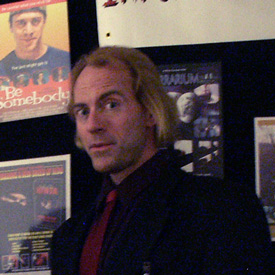
because ... well ... why not ...?
it's a dirty job, but somebody's got to do it.
- Monday, July 24th
- 18:51PM
- 18:51PM
- 2P or not 2P?
Panasonic's new high-def camcorder, the HVX-200 is a cool but peculiar beast to work with sometimes. For starters, it uses Panasonic's semi-proprietary P2 memory cards to store video. They're essentially a bank of compact flash memory cards running RAID 1 inside a standard PCMCIA card shell. Cute idea, but pretty pricey at the moment, and you can only record a few minutes of video at a time before the card fills up and you have to swap it with another blank card or stop to copy the video files off onto a computer.
So far, I think I'm less horrified by this detail than anyone else. Most people are used to shooting on videotapes that pack an hour or thereabouts onto a single, inexpensive tape cartridge, so being able to shoot for eight minutes at a stretch before changing cards seems like an absurd step backwards.
And if you're doing event videography, shooting a sporting event, conducting an interview, or taping a conference, I can see how that would be a major limitation.
But I'm coming at it from the standpoint of making feature films, and you don't shoot those that way. Normally you set up a shot, do a few takes in a couple of minutes, and then you have to stop and set up a new shot regardless of the needs of the camera. Coming from a making-films-with-actual-film background, being able to shoot eight minutes at a stretch (more-or-less; it depends on the camera settings and, especially, how much you were willing to spend on P2 cards) isn't much different than being limited to the length of a film reel (often eleven minutes, but sometimes even shorter than that). The truth is that eight minutes is a *long* time, especially when you're shooting action movies. Besides, with straight-to-digital cinematography, you don't have to stop and wait nervously after each set-up for the camera operator to check the gate and possibly make the dreaded announcement, "Hair in the gate!" that lets you know you all have to start over again.
Luxury.
Now the HVX-200 does actually have a tape drive. However, it only records standard definition video to the tape, so there's not really much point in it having said tape drive. I would rather have left out the tape mechanism in favor of producing a cheaper and lighter high-definition camera. I already have plenty of standard-definition cameras.
But having to empty the memory cards every few minutes of shooting does present one obvious problem: the cards have to be emptied onto *something*, and it needs to be something nearby. And that's where Larry comes in.
Meet Larry:
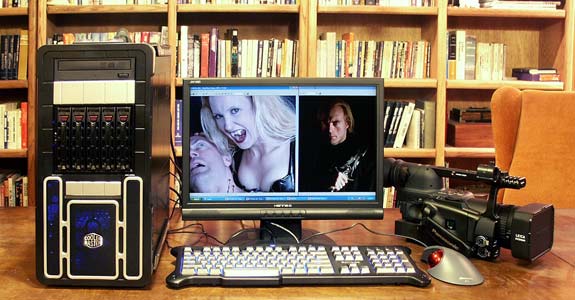
What I needed was a transportable computer system capable of storing huge quantities of data reliably, able to copy the high-definition video files off the P2 cards or the camcorder, and capable of converting the raw high-definition video into a format that the director, cinematographer, producer, etc., could take home and review at the end of the day. That's actually a taller order than it sounds.
For luggability, I picked the Coolermaster Ammo 533 case which is a strong contender for the coolest-looking computer case currently available. Of particular importance, it features a sturdy and comfortable carrying handle on the top. I like this case a lot and recommend it highly.
For the storage issue, I got a Supermicro 5-drive hot-swap SATA array which fits five drives nicely in three standard drive bays, after I spent a little bit of quality time "adjusting" the case with a small crowbar and a particularly large screwdriver. No biggie. Though computer cases are actually astoundingly better designed than they were only a few years ago, I'm still pretty happy with any case that doesn't require the use of a cutting torch or violating the laws of physics to install components into.
The array is populated with 500 gig hard drives running RAID 5 (so that if a drive fails, the production company doesn't lose the entire movie). I would have liked to fill it with 750 giggers, but at the time I priced and bought all the parts (a few weeks ago now), those would have cost me more than twice what I could get the 500s in for. I grabbed an extra to have on hand, and with the hot-swap drive array, if there's a failure on the set, there'll be an absolute minimum of disruption of the shooting while the spare gets popped in.
Because this system will often be set up in dark or poorly-lit areas, I selected the Saitek Eclipse Keyboard, which features blue backlighting that illuminates the letters on the keycaps. Kind of the opposite design philosophy of the one that inspires Das Keyboard (which would probably make a fine gift for someone even uber-geekier than I, if you can imagine such a thing, but don't get me one, or you'd wind up getting subjected to even more typos than I make already).
In keeping with being able to find things in the dark, I got a Microsoft Optical Trackball that lights up red around the trackball ball. While that might be a fine feature on a dark movie set, I also found this particular trackball annoying and awkward enough to use under both bright and dark conditions that I personally wouldn't recommend it. If you just need to be able to locate your pointing device in the dark and don't actually need to use it, then this might be just the ticket for you, however.
...yeah, really. When you're making a zombie movie, some percentage of your cast may have already had their hands fall off and, as such, won't be big on actually using the trackball. They probably will be quite happy enough just standing there, swaying slowly back and forth, moaning, "ooohhh...pretty!" at the sight of this state-of-the-art red-glowing USB trackball. I think it's important to design a system like this to appeal to both the living computer power-user and the dead (or undead) non-computer-expert.
The guts of the beast feature a dual-core Athlon X2 64 CPU cooled by this Thermaltake Blue Orb II cooling fan. One advantage of this CPU cooler for this application is that the great majority of the weight is next to the mainboard. With a system that's being lugged hither and yon, tacking on one of the really tall heatpipe coolers that put most of the weight much further from the board might throw a bit more stress on the board. How big an issue that really would be in practice, I don't know, but I figured that anything that lessens the probability of the processor bursting into flames just after you drove into the outskirts of Yon was a fine idea.
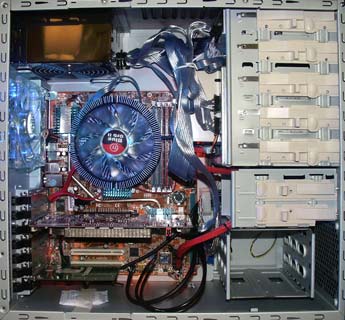
Abit AN8 32X board, Supermicro SATA hot-swap array, and some other stuffApart from the big pile-o-hard drives, the priciest component was the ATI Radeon X1900GT. That's a little more serious than absolutely necessary for high-definition video capture, transfer, and editing, but my hope is to take advantage of ATI's hardware-assisted AVIVO format conversion software to take the dailies and transcode them into something the director, etc., can take home in a reasonable amount of time. Granted, that's not quite a mature technology right at the moment, but I decided to give it a try anyway. When you're transcoding high-definition video, you need all the help you can get. I know I've had my share of marathon sessions surrounded by an array of computers all chugging away on different video segments to get the dailies transcoded and ready for review and/or editing in time.
The question remains how well it's going to work in the field. I'll keep you updated as the testing progresses.
- Saturday, July 22nd
- 12:38PM
- The Devil in the Details:
It's starting to look like this is shaping up to be the most Western-Horror intensive season yet for me.
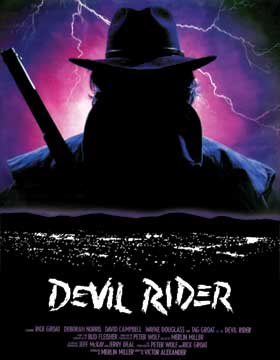
Theoretically, I might be starring in a Wild West Zombie movie later this year, and right now I'm working on getting a fine Wild West Action/Horror film, Devil Rider ready for worldwide distribution.
It's a pretty cool flick, and I like the poster a lot. I haven't seen the trailer yet, and there's a reason for that which we'll get to in a moment.
Part of the challenge of dealing with independent film (or, really, any kind of film) is the sheer range of technological options filmmakers have availed themselves of for the project. The about-to-start-shooting horror flick Redneck Vampires is being shot on a couple of Panasonic's new HVX-200 high-definition camcorder (more about that project later) That's pretty close to state-of-the-art in the budget filmmaking world, and the fact that the equipment and the recording format have only been around for a few months certainly adds to the adventure.
Devil Rider, on the other hand, was shot on 35mm film, but the video transfer masters are on one-inch type-C reel-to-reel videotape.
That adds a new, important step to the process of DVD authoring and production: Find someone who has a one-inch type-C reel-to-reel video deck. They're not too common. They're also not small, so at least there is the advantage that if someone does have one of these babies, they probaby know it. It's not going to be forgotten somewhere on a shelf in the broom closet.
The copy of the trailer I have--which is not the master (and the real master does exist, fortunately; I just haven't gotten my hands on it yet)--is three-quarter-inch Hi-Band PAL U-Matic. Even I have a couple of U-Matic decks banging around, but not ones that'll read Hi-Band PAL, which is a variation only used in Europe. I do have some PAL gear, but not of the U-Matic flavor.
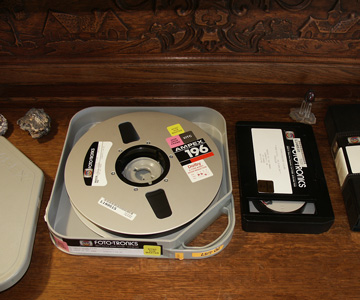
1" reel-to-reel tape, type C, and Hi-Band PAL UMaticObviously, I could do a new video transfer from the 35mm print--and, eventually, that probably will get done, since that's the only realistic way to get it into a modern high-definition video format--but for getting it ready for distribution right away, I'm going to try to work with the tape.
But with luck--and a little video/electronic wizardry--the Devil will soon be riding again. Watch out!
- Saturday, July 22nd
|
Trygve.Com sitemap what's new FAQs diary images exercise singles humor recipes media weblist internet companies community video/mp3 comment contact |
|
|
